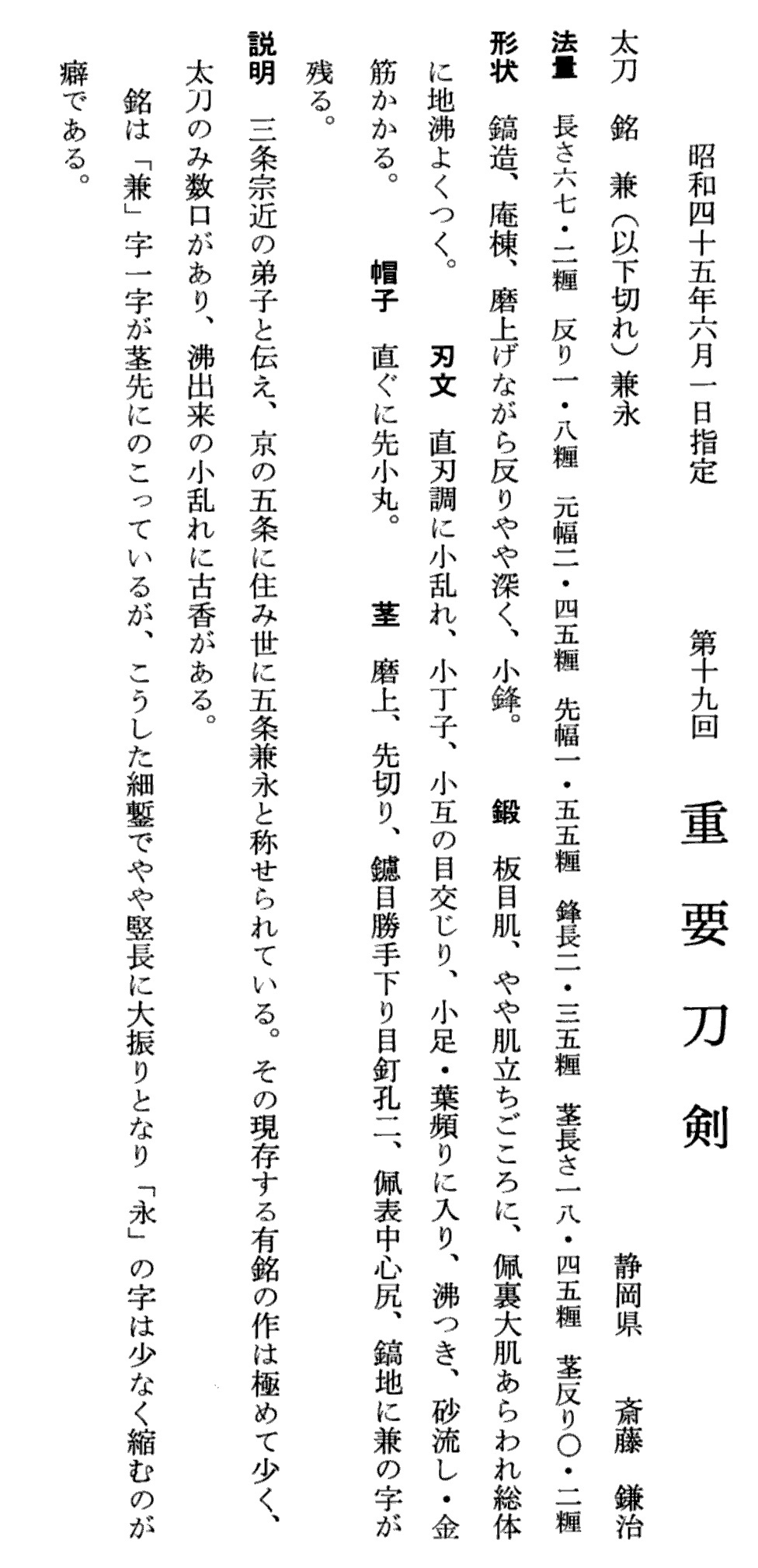Gallery Page (Display Only)
Kanenaga of Yamashiro
Heian Era, Approx. 1000 + years old!
Juyo token by the NBTHK
saya-gaki by, KANZAN, Dr Sato
J?y?-t?ken at the 19th j?y? shinsa held on June 1, 1970
tachi, mei: Kane… (ika-kire) (Kanenaga) (?????????) – “Kane… (below cut off, but signature is that of Kanenaga)”
Shizuoka Prefecture, Sait? Kamaji (????)
Measurements
nagasa 67.2 cm, sori 1.8 cm, motohaba 2.45 cm, sakihaba 1.55 cm, kissaki-nagasa 2.35 cm, nakago-nagasa 18.45 cm, nakago-sori 0.2 cm
Description
Keij?: shinogi-zukuri, iori-mune, despite the suriage a deep sori, ko-kissaki
Kitae: rather standing-out itame that displays some ?-hada on the haki-ura side and that features plenty of ji-nie all over the blade
Hamon: suguha-ch? in nie-deki that is mixed with ko-midare, ko-ch?ji, ko-gunome, many ko-ashi and y?, and sunagashi and kinsuji
B?shi: sugu with a ko-maru-kaeri
Nakago: suriage, kirijiri, katte-sagari yasurime, two mekugi-ana, the haki-omote side retains at the tip and in the shinogi-ji of the tang the character for Kane
Explanation
Kanenaga (??) is said to have been a sudent of Sanj? Munechika (????) and as he was residing along the Goj? main street of Ky?to, he was and is referred to as Goj?-Kanenaga (????). Only very few signed works exist by Kanenaga, which are all tachi and are hardened in a classical ko-midare in nie-deki.
In case of this blade, the character for Kane (?) retains at the tip of the tang, but the character being executed with a thin chisel and in a somewhat large and vertically stretched manner, it shows the typical hand of Kanenaga, who then executed the subsequent character for naga (?) in a comparatively smallish manner.
Article by Dr. Honma Junji
http://www.touken.or.jp/english/nihon_koto_shi/(5)%20No.551.htm
3. Munechika and his school
It is said that Munechika lived in Sanjo of Yamashiro Province around the Eien Era (987-988) and he is also called ‘Sanjo’ and ‘Ko-kaji’. He has been a very famous smith from olden times and his great reputation is substantiated by his extant works like meibutsu ‘Mikazuki Munechika’ (‘Tenka Go Ken’ or one of the five greatest swords in Japan) and a tachi of the Imperial sword collection. Meibutsu Mikazuki Munechika is a little tired after many polishes but still maintains classic elegance and dignity. The jihada of the tachi is beautiful and has dense itame-hada that does not appear to have been folded many times during forging. The jigane looks soft in comparison to that of Yasutsuna and Ko-Bizen swords and is covered with thick and fine ji-nie. The hamon is ko-midare in ko-nie-deki with a thick nioi-guchi then many uchinoke are overlapped and become niju-ba and sanju-ba, and it starts with very short yaki-otoshi. The sword somewhat reminds one of Kogarasu-maru and Shoso-in swords even though the sugata is different, and the whole workmanship looks older than that of Yasutsuna and Ko-Bizen swords. Yaki-otoshi is seen in early Japanese swords such as Yasutsuna, Ko-Bizen and Kyushu swords occasionally, therefore they should not be mistaken for sai-ha (re-tempered swords). There are few extant works of Yamato swords made in the Heian Period but a certain number of extant works of the Kamakura Period and they show fairly classic workmanship with narrow hamon in the bottom area. The Reimei-kai Museum of the Owari Tokugawa family owns a tanto with the signature of Munetsugu. The blade is hira-zukuri and has uchi-zori and hoso-sugu-ha. I suppose this is a very rare example of tanto made in the early Kamakura Period.
Yoshiie, Kanenaga, Kuninaga and Arinari are said to be sons or grandsons of Munechika and there are fine extant works by them. It is believed that Kanenaga and Kuninaga lived in Gojo in Kyoto and so they are called Gojo Kanenaga and Gojo Kuninaga. They forged a finer jihada than that of Munechika and temper ko-midare in a more artificial pattern so that they also are recognized to have been active later than Munechika. Yoshiie often tempered hamon mixed with middle-sized choji, therefore he seems to have been active in the Kamakura Period. Also there is a theory that he is a Bizen smith since he tempers fairly gorgeous choji-midare but his active age has yet to be studied.
This Sword is not available for purchase.
If you wish to purchase a Japanese Sword, please view our Nihonto for sale page or contact us directly via email or by telephone at 1(608) 315-0083 any time. Please include specifics of what you seek, i.e.: Katana, maker, era, price range, etc.
Pictures and content may not be copied without the express permission of samuraisword.com ©








